The Untold Truths About a Movement That Was Meant to Liberate — and How It’s Been Twisted
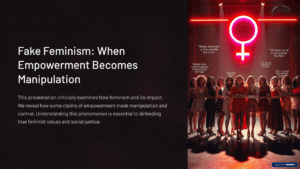 Has Feminism Been Hijacked?
Has Feminism Been Hijacked?
“Feminism started as a revolution. Today, it’s a marketing strategy—and sometimes, a joke.” Do you think it is going smoothly? Nah! Do you know how this story started? The wave formally began at the Seneca Falls Convention in 1848, when three hundred men and women rallied to the cause of women’s equality. Elizabeth Cady Stanton (d. 1902) drafted the Seneca Falls Declaration, outlining the ideology and political strategies of the new movement.
These were women who risked everything, not for likes, but for legislation. They demanded the vote, property rights, and the simple right to be heard. This wasn’t empowerment in pink—it was revolution in ink and action. Feminism was never just a word — it was an emotion, a struggle, and the hard-earned legacy of countless courageous women. But today, that legacy is being misused by a few, turning what was once a movement of liberation into a weapon of exploitation. In this article, we confront a rising concern: the women who have come to idolize fake feminism, and how their actions are distorting the very meaning of equality.
Feminism: A Movement Born in Pain and Truth
Feminism wasn’t born out of comfort. It emerged from women’s cries for dignity, safety, and basic
human rights:
Here’s a more detailed look at some key areas:
● Equal Pay and Workplace Equality:
Feminist actions include fighting for equal pay for equal work, challenging gender discrimination in the workplace, and ensuring women have equal opportunities for advancement.
● Reproductive Rights:
This includes advocating for access to abortion, contraception, and other reproductive healthcare services, as well as challenging restrictions on these rights.
● Women’s Suffrage:
This involves advocating for the right of women to vote and hold political office.
● Access to Education:
Feminists work to ensure that women have equal access to education at all levels, from
primary school to university.
● Combating Gender Stereotypes:
This involves challenging traditional gender roles and expectations and promoting a more
diverse and inclusive understanding of gender.
● Protection against Sexual Violence:
This includes advocating for laws that protect women from sexual harassment, assault, and
other forms of sexual violence.
● Bodily Autonomy:
This involves advocating for the right of individuals to make their own decisions about their
bodies, including decisions about pregnancy and childbirth.
“Feminism was never meant to be pretty. It was meant to be powerful.”
🧨The Betrayal: When Feminism Became a Fashion Statement
1. The Commercialization of Feminism:
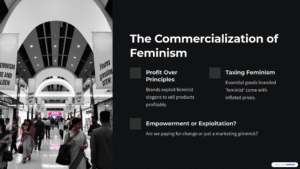
Welcome to the Era of Fake Feminism — and it’s bigger than you think.
If you believe it’s just women or Instagram feminists misusing the word feminism, think again. Let’s talk about the real players in the game — the big brands and industries that have mastered the art of commercializing empowerment.
From the Pink Tax to the Beauty Tax, the Tampon Tax, the Motherhood Penalty, and the ever-growing Empowerment Merchandise Trap — feminism has become a marketing tool, not a movement. But before we break down the profit machine, let’s start where it all truly began — with the emotion behind the revolution.
2. Filtered Faces, Filtered Feminism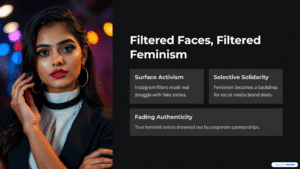
Faces with filtered selfies discuss the aesthetic of feminism. We’ve entered a world where empowerment comes with filters and hashtags.
Instagram influencers, cloaked in curated perfection, promote products under the name of feminism — but do they care if it aligns with the movement’s core values? Not really.
They blur the line between advocacy and advertising, misleading women and teenage girls with
aesthetic slogans and shallow narratives. The result? A version of feminism that damages mental
health, distorts expectations, and prioritizes profit over progress.
“When feminism becomes a backdrop for brand deals, it loses its soul.”
 3. The Sisterhood Breakdown:
3. The Sisterhood Breakdown:
We’ve all heard of the bro code — an unspoken rule of loyalty and support among men. In contrast,
the sister code should embody empathy, protection, and unity among women. But in today’s world of fake feminism, sisterhood is often weaponized:
● Some women uplift only those who fit their aesthetic or agenda.
● Others tear down fellow women under the mask of “empowerment” or competition.
● The so-called “sisterhood” becomes a club — exclusive, judgmental, and performative.
“When sisterhood becomes conditional, it’s not empowerment — it’s elitism.”
True feminism means standing for each other, even when it’s uncomfortable. It means calling out
injustice — even when it comes from within.
 4. The Broken Trust:
4. The Broken Trust:
In the rising crowd of fake feminism, the voices of real feminists are being drowned out. What once
stood for justice and equality is now facing a credibility crisis. Fake feminism has blurred the lines so much that it’s creating deep trust issues around the word itself. As a result, many now associate feminism with hypocrisy, exclusion, or manipulation—leading to a growing cultural shift where people don’t just question feminism… they boycott it.
“When feminism becomes performative, anti-feminism becomes persuasive.”
The Weaponization: When Feminism Is Used to Control, Shame, or Manipulate
Sometimes, the real problem isn’t just being toxic—it’s weaponizing feminism to justify it. There
are girls—not yet women—who use the language of feminism not to empower, but to excuse their
harmful behavior. From promoting cancel culture to manipulating narratives for personal gain, they distort a movement built on justice into one that serves individual agendas.
Cancel culture, one of the worst things we can talk about, is the practice of publicly calling out,
shaming, and boycotting a person—often on social media—because of something they said or did
that is perceived as offensive, problematic, or morally wrong.
Here’s how it typically plays out:
● A person (celebrity, influencer, or even a private individual) says or does something controversial.
● Others online highlight this behavior, often with viral posts.
● A digital backlash follows, including:
○ Demands for apology or punishment.
○ Loss of sponsorships, jobs, or social standing.
○ Mass unfollowing or boycotting.
When Cancel Culture Meets Fake Feminism:
In the context of fake feminism, cancel culture is often misused to:
● Silence opposing views (especially from men or dissenting women).
● Avoid accountability by labeling criticism as “misogynistic.”
● Gain attention by playing the victim rather than engaging in meaningful dialogue.
“Cancel culture isn’t always about justice. Sometimes, it’s about control.”
“When feminism is used to silence rather than support, it loses its soul.”
👑 When “Feminism” becomes a shield for toxic behavior, examples include:
● Gaslighting or playing the victim in relationships, then hiding behind feminist slogans like
“Don’t police women’s emotions.” Have you ever gone through the concept of what
gaslighting is? Gaslighting is a form of psychological manipulation where someone makes you
question your reality, memory, or perceptions in order to gain control or power over you.
● Publicly shaming men for minor disagreements and labeling it as “calling out toxic
masculinity.”
● Using feminism to justify cheating, lying, or ghosting — while preaching “self-love and
growth.”
● Cancelling people for personal gain, rather than real accountability.
“Real feminism challenges systems — not individuals for sport.”
This isn’t about dismissing women’s struggles. It’s about calling out a dangerous pattern that
distorts the goals of the movement.
The Feminist Façade: Who’s Benefiting from the Lie?
Here come the real players in the game—they perfected the subtle craft of turning empowerment
into a profitable commodity. If you thought only social media influencers were misusing feminism,
think again.
Did you know about the Pink Tax, Beauty Tax, Tampon Tax, Motherhood Penalty, and the
Empowerment Merchandise Trap?
These aren’t just concepts — they are calculated strategies to profit off of women’s empowerment.
Feminism has become a marketing buzzword, repackaged into slogans, T-shirts, and overpriced
products wrapped in pastel packaging.
💄 1. Beauty Tax
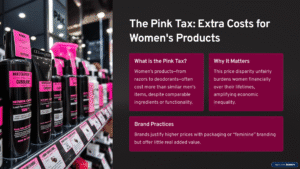
● Women are socially pressured (and often professionally expected) to invest in grooming,
makeup, skincare, hair styling, and fashion.
● On average, women spend significantly more than men on appearance-related products and
services — not out of choice, but out the societal expectation.
● Brands often market these expenses as “self-love” or “confidence” boosters”—commodifying empowerment.
Empowerment should be a right, not something sold at a beauty counter.
2. Period Tax (Tampon Tax)

● Many governments treat menstrual products as luxury items and tax them, while items like
condoms or even Viagra are tax-free in some places.
● Some companies use feminism-driven marketing to sell “fancy” period products at higher
prices, capitalizing on a basic biological need.
Periods aren’t a luxury. They shouldn’t be taxed like one.
3. Motherhood Penalty
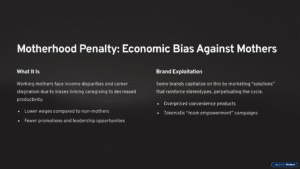
● Women face career disadvantages for becoming mothers: lower raises, fewer promotions, and gaps in employment history.
● Meanwhile, brands market expensive “mom empowerment” gear, childcare gadgets, or
self-care kits — often priced higher than practical alternatives. Motherhood isn’t a branding strategy. It’s a full-time, undervalued job.
4. Empowerment Merchandise Trap
 ● “Boss Babe” mugs, “feminist” tees, and self-help books often come at premium prices — but
● “Boss Babe” mugs, “feminist” tees, and self-help books often come at premium prices — but
offer no real support or activism.
● The message is clear: Buy this to be powerful. It reduces feminism to a lifestyle aesthetic.
You shouldn’t have to buy a slogan to believe in yourself.
The Quiet Victims of Fake Feminism: The Men No One Talks About
Feminism began as a powerful movement to secure equality — but in recent times, it has, for some men, turned into a source of fear and injustice. Are you familiar with the term misandry? It refers to the hatred, contempt, or prejudice against men or boys. The word derives from the Greek roots miso-, meaning “hatred,” and Andros, meaning “man.” Today, certain individuals are misusing laws and policies originally designed to protect and empower women, turning these tools of justice into weapons of manipulation. This misuse is not hypothetical — it’s real, and it’s happening. In India alone, numerous cases of false accusations and exploitative behavior in the name of feminism have surfaced. Below, we explore two such cases that reveal the darker underbelly of what happens when feminism is twisted into something it was never meant to be.
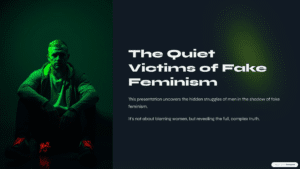 The Silenced
The Silenced
Men who supported feminism are now often
● Labeled as problematic for sharing emotional thoughts.
● Mocked for being survivors of abuse.
● Ostracized for questioning double standards.
These men are everywhere. They just don’t speak—because it’s safer not to.
💥 The Accused Without a Trial
Fake feminism has enabled false allegations that have ruined lives.
● Jobs lost.
● Reputations destroyed.
● Mental health shattered.
Justice requires evidence—not online mobs. Real feminists should be the first to demand fairness.
🧠 The Emotionally Numb
Fake feminism shames men for being human.
● Tears make them weak.
● Emotions make them manipulative.
● Silence makes them toxic.
We taught men to feel less—then blamed them for being distant. And we wonder why they shut down.
🤝 This Is Not About Blaming Women. It’s About Telling the Whole Truth.
Feminism should never mean silencing others for empowerment.
“Fake feminism told some women they could only rise by pushing men down. That’s not feminism.
That’s ego wrapped in pink packaging.”
Real vs. Fake vs. Anti: The Battle
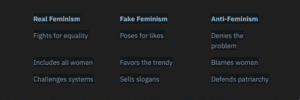
“In the noise, real feminism is getting lost. And with it — real women’s voices.”
The Backlash: How Fake Feminism Fuels Anti-Feminism
Fake feminism doesn’t just weaken the movement—it strengthens its enemies. When feminism looks shallow, performative, or hypocritical, it becomes easy for critics to dismiss the entire cause.
We’ve seen the rise of anti-feminist influencers like Andrew Tate and the growing influence of red pill and MRA (Men’s Rights Activist) communities. Their appeal often comes from the void left by fake feminism.
“Did fake feminism set the stage for feminism’s enemies?”
It’s a question we can’t ignore. If we don’t confront fake feminism, we give power to the narratives
that seek to tear down real feminism.
Naming the Names (Without Shame, But With Truth)
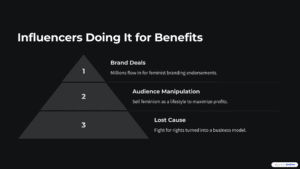
This isn’t about canceling—it’s about confronting. Examples include:
● Influencers profiting off unrealistic beauty standards.
● False accusers who hurt real survivors.
● Movements that silence instead of unite.
“Calling this out isn’t anti-woman. It’s pro-truth.”
How to Heal Feminism — Without Hurting Each Other

We need emotional repair. Feminism should mean :
● Listening before judging.
In a world of viral outrage and instant opinions, we often forget the most radical form of empathy: listening. Real feminism begins with understanding, not assumption. Before we cancel, criticize, or condemn, we must first listen to the full story especially when it challenges our own beliefs. Because judgment without context isn’t justice — it’s noise.
● Holding everyone accountable.
Holding everyone accountable means applying the same standards of justice and responsibility to
everyone—regardless of gender, popularity, or platform. In the context of feminism, this means:
❖ Calling out toxic behavior, whether it comes from men or women.
❖ Challenging harmful actions even if they’re committed by those who claim to represent
feminism.
❖ Ensuring that justice movements don’t turn into shields for manipulation or double standards.
True equality demands fair accountability—not selective silence.
● Returning to truth and inclusion.
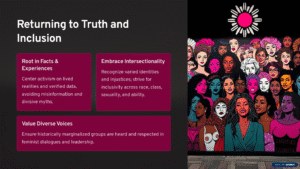
Returning to truth and inclusion means steering the feminist conversation back to its
original, honest purpose: equality for all, not selective empowerment. It involves
rejecting performative activism and embracing diverse voices—across race, class, gender,
and experience. By doing so, we ensure feminism doesn’t become an exclusive club, but
a real force for justice.
“Real feminism listens to every story—not just the ones that trend.”
“Real feminism has space for softness and strength, vulnerability and fire. But it has no
room for lies.”
Fixing the Feminist Mess: How to Spot and Stop the Fake
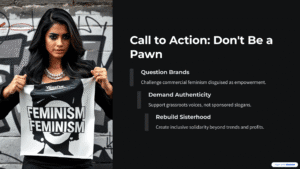
What can we do?
● Support grassroots, intersectional activism.
● Call out performative feminism.
● Prioritize integrity over image.
● Educate yourself—beyond hashtags.
“Real feminism doesn’t need filters or merch. It needs courage.”
Final Words: You Don’t Need a Hashtag to Be a Woman Worth Hearing
End on a human note. Maybe your mother, a friend, or a teacher who never shouted feminism—but
lived it every day.
“Feminism didn’t start on social media. And it won’t survive there unless we bring back
the truth.

